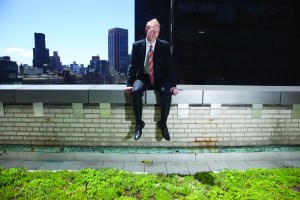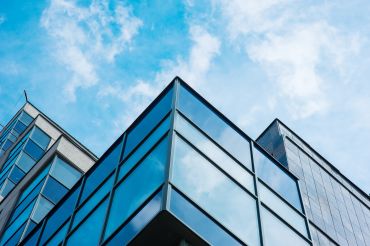SL Green’s Jason Black Is Commercial Real Estate’s Al Gore
By Tom Acitelli July 26, 2011 8:49 am
reprints
It all began, modestly enough, with the relatively simple task of implementing an energy-savings plan across Reckson Associates’ portfolio of 32 buildings in Westchester and Fairfield counties.
A regional architect with Reckson named Jason Black orchestrated a portfolio-wide program that included the installation of L.E.D. exit signs and occupancy sensor devices in private offices. After it was evident that those measures were paying off, Mr. Black made another smart call: a $1.5 million lighting retrofit throughout the portfolio’s 4.5 million square feet that not only proved to be 50 percent more energy efficient but also resulted in a $600,000 windfall in tax incentives from state utility agencies.
This was in 2007, before sustainability had risen to its current vogue among commercial real estate developers. Mr. Black was 27 years old.
“While I had always been interested in sustainability—it was something core to who I am—I really began to see the opportunities to fold it into business,” said Mr. Black, now 32, who stayed on with Reckson Associates in 2007 after it was acquired by SL Green (SLG). “I started to develop these small programs, and the team up in the suburbs were very open to exploring these possibilities.”
Mr. Black’s suburban success, and his ability to think creatively in an area of real estate still in its nascency, weighed heavily in SL Green’s decision last month to name the whiz kid the REIT’s first-ever director of sustainability. The position, while still being carved out, makes the New York State native responsible for sustainability issues for one of the largest property owners in the five boroughs and their suburbs.
“There has been a lot of enthusiasm down here in the city, and there’s a lot of projects that have been put into the works, whether it’s by the operations team, or the leasing team, or etc.,” Mr. Black said. “And they wanted to be able to round all of that up and have a central person take all the enthusiasm, and take all of these accomplishments, and really bring it all to the next level.”
All that enthusiasm, quite frankly, has been conspicuous so far. During a tour earlier this month of 100 Park Avenue, a LEED-certified building with tiered terraces fitted with a rain water-absorbing vegetated roof, Mr. Black’s visage blared across Captivate Network elevator screens as a sort of introduction for office tenants. As a result, he says, his first few months have been spent greeting tenants who saw him on-screen and answering all their eco questions.
“We’re here to assist them,” Mr. Black said. “They’re all interested to hear more about the program we have going on, but also to lend insight about what they can do in their own space and also how they can control and improve those sustainable elements that we’re now introducing.”
More specifically, the REIT’s greening initiative has turned to an innovative carpet and ceiling-tile recycling plan. Since the program began in 2007, SL Green has recycled more than one million square feet—or about 500 tons—of debris from its suburban properties. In only the past few months, meanwhile, the plan has been implemented rather successfully at 280 Park Avenue, where 100,000 square feet of carpet and ceiling tile has already been removed amid renovations.
In Greenwich, Conn., meanwhile, where SL Green owns a collection of properties, a photovoltaic system was installed at 500 West Putnam Avenue earlier this year. As in other buildings using the device, it has been responsible for reducing energy use by approximately 5 percent a year, Mr. Black said recently.
Among SL Green-owned buildings in New York State, the green initiatives extend to nine assets that have earned the Energy Star Label, a designation awarded by the Environmental Protection Agency to properties that achieve energy-saving benchmarks in water conservation, recycling and the implementation of L.E.D. bulbs.
For Mr. Black, however, each building offers another opportunity to stretch his imagination. After all, as he sees it, sustainability in commercial real estate is still largely a blank canvas.
“We have an opportunity to be able to try new things that aren’t necessarily mainstream yet,” he said. “You can follow other examples—and my big thing is to be able to talk to others in the industry and understand what they’ve done, and see if it’s applicable here—but it’s also about carving your own road. There’s a great opportunity to continue to be a trailblazer in this field, and setting the tone for defining what sustainability really means.”
But Mr. Black’s green enthusiasm crosses over to his private life as well. With his land-use attorney wife, Meredith, the former architecture student has turned their home in the small northern Westchester town of Katonah into a reflection of their shared passion for the environment.
To be sure, the couple has installed spray-foam insulation into their roof, attic and the walls on the second floor. Meanwhile, they retrofitted their heating system to make it more energy efficient—an endeavor that has paid off to the tune of about $1,200 annually in heating oil savings. The pair even explored the possibility of installing solar roofs, but decided that, with so many trees spread across their bucolic backyard, the endeavor would have cost too much.
“I always have a tough time knowing who’s holding the reins,” said Mr. Black, who grew up in Rye and has always lived upstate. “We’re both highly ambitious. Frankly, we’re both highly efficient.”
jsederstrom@observer.com


